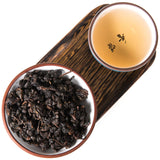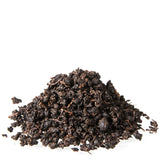One chilly autumn morning, the Wise Tea Master and his disciple were getting ready for morning meditation up in the mountains of Nantou, Taiwan.
— Master, the morning is yet so young, and I have no energy. I'm afraid I won't be able to sit and meditate.
— Here, drink some of this tea.
The disciple, after taking a sip:
— Master, the aroma is so comforting, like morning coffee. Yet, the tea is sweet, like chocolate. I feel vital energy moving through me after just one sip.
— The locals call it Lao Cha. It's an Aged Oolong. Now, let's begin our meditation.
Have you ever tried Aged Oolong Tea before? We're sure you'll be completely mesmerized by the complexity of its flavor! Our 10-year-old Lao Cha Oolong Tea is aged with repeated yearly roasting.
Aged Oolong is not a widely common tea. The tea masters must store the tea leaves for at least three years to be considered aged. The longer they age the tea the more complex the flavors become. However, anywhere from 10-20 years is regarded as the "golden middle" of aged oolong tea.
Tea makers keep oolong leaves in stone or clay vessels for optimal aging. Every year, the tea master examines the tea leaves and re-roasts them over charcoal to remove excess moisture and deepen the taste.
In Taiwan, where oolong aging is a century-old tradition, three prerequisites state which tea is suitable for aging:
• First, it must be a traditionally crafted tea; each step of its processing should adhere to traditional standards (especially baking).
• Second, only high-quality oolong has an aging value. If the tea leaves are of low quality, time will not add to their already weak aroma and taste; instead, they will become bland and tasteless.
• Third, one should observe the proper storage conditions. The storage method for aged oolong tea is very particular. Tea masters need to abide by strict storage rules to ensure a satisfactory end product.
What does aged oolong tea taste like? Many who haven't tried aged oolong might initially imagine it's that of an aged raw pu-erh. However, the two teas differ significantly in their flavor profiles. Aged oolong is remarkably sweet, mellow, and smooth. The taste is complex and unique. A Gong Fu style infusion will reveal an orange-golden tea soup. The entrance is sweet and smooth, as this aged oolong will slowly uncover its layered, complex character along with the number of infusions. A sweet and soft entrance with top notes of exotic fruits and vanilla leads to a rounded body of cacao and honeydew hints. The long lingering base notes of chocolate and coffee will end this remarkable tasting, leaving a sweet aftertaste both in the mouth and on the cup's bottom. Aged oolongs usually have lower caffeine content.
Our Lao Cha Aged Oolong is made from the Ruan Zhi cultivar, also known as Qing Xing. Qing Xin (translates as "Green Heart") is a tea cultivar prominent in Taiwanese High Mountain Tea farming. First, the tea undergoes 50% oxidation, followed by an initial dark roast, and then years of storage with repeated yearly roasting. Taking a sip, you'll undeniably notice this tea's prominent Cha Qi — the tea's soul or energy that fills your body with each sip.
When brewing this tea in small tea vessels according to the ways of Gong Fu Cha, you can effortlessly get 20 flavorsome and fragrant brews of mellow oolong.
- Place of Origin: Lugu Village, Nantou County, Taiwan
- Altitude: 1000m
- Harvest Date: September 2014
- Picking Standard: Three leaves
- Roast: Dark, charcoal roasted
- Aroma: Cherry tobacco
- Taste: Vanilla, chocolate, cacao.
- Cultivar: Ruan Zhi (aka Qing Xin, TRES #17)
Brewing guidelines:
![]() 205℉ / 95℃
205℉ / 95℃
 1g per 70-100ml
1g per 70-100ml ![]() 3-4min
3-4min
 1g per 20ml
1g per 20ml ![]() 10sec + 5sec for each subsequent infusion
10sec + 5sec for each subsequent infusion





